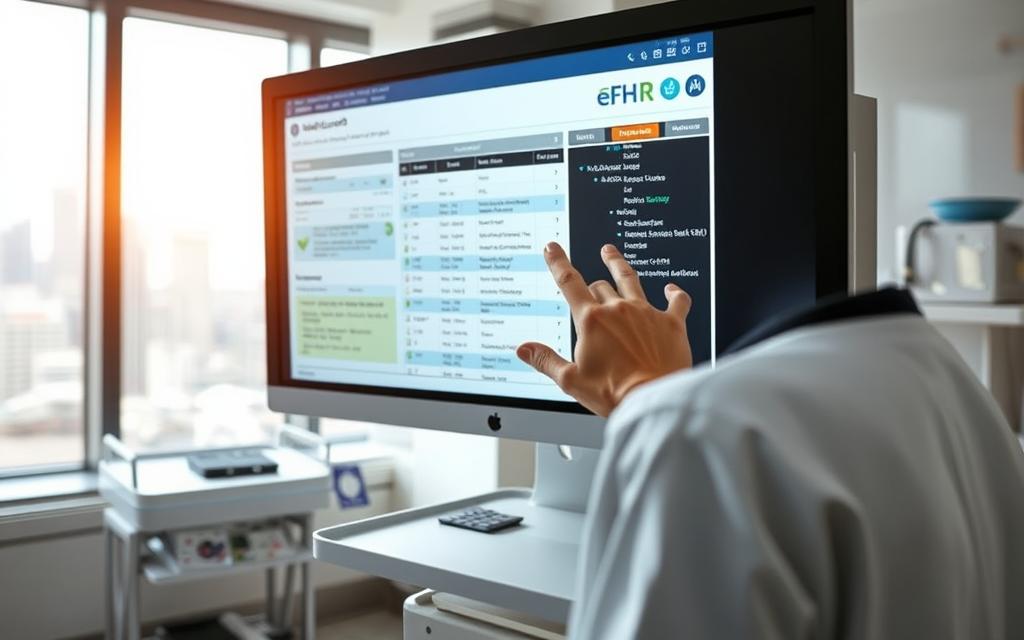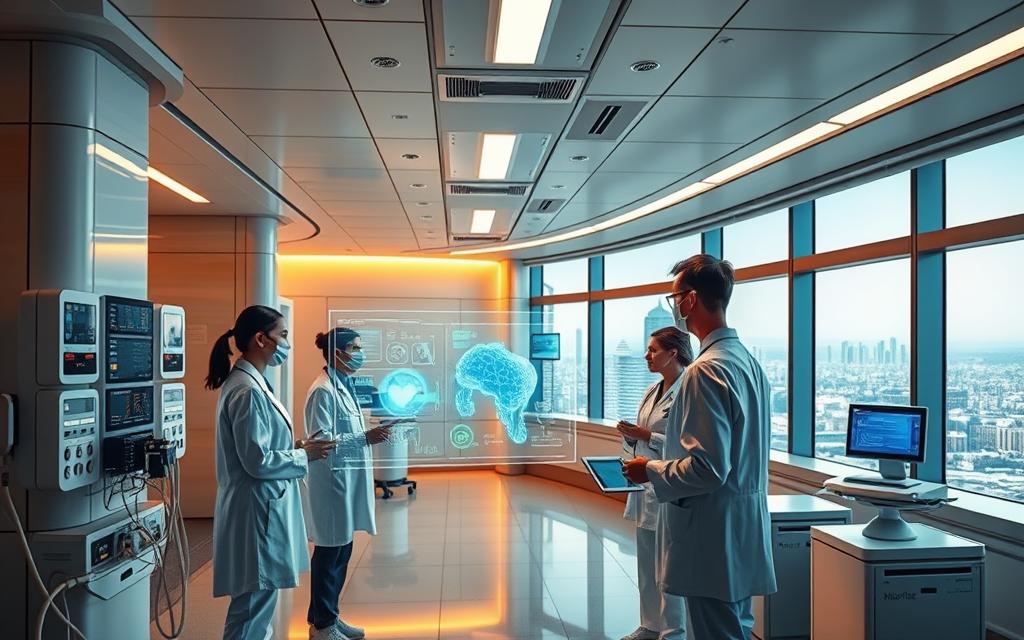Medical practices have seen extraordinary changes over the years. Doctors now use cutting-edge systems instead of old tools. This digital healthcare transformation has come a long way, from the stethoscope to AI.
Today, electronic health records (EHRs) show the medical technology benefits on a large scale. They keep patient histories in one place, making care more accurate. Telemedicine also lets specialists help people in remote areas, a big change from the past.
Three key areas are driving progress:
• Real-time data analytics in clinical decisions
• Automated tools for clinician workflow optimisation
• Wearable devices for constant patient monitoring
These advancements do more than just update tools. They change how doctors work together. With 3D printing and big data, care is getting more personal. This leads to quicker recoveries, fewer mistakes, and benefits for both doctors and patients.
The Role of Technology in Modern Medical Practice
Healthcare has changed a lot with the digital revolution. It has changed how doctors work together and make important decisions. This change from old ways to new systems is both exciting and challenging for medical staff.
Evolution of Healthcare Delivery Systems
The move from paper to digital ecosystems is a big change in healthcare. Where paper files used to be everywhere, now cloud platforms let doctors access data quickly across networks.
Transition From Paper Records to Digital Ecosystems
Three key things helped make this change:
- The 2009 HITECH Act encouraged doctors to use EHRs
- Standard data formats made sharing easier
- In 2022, CMS SAFER Guides made systems safer
Studies show that this change cut down on mistakes by 30% in some hospitals.
Impact on Clinician Workflows and Decision-Making
Today’s systems focus on giving doctors actionable insights quickly. For example, doctors at Massachusetts General Hospital cut down diagnosis times by 22% with AI in EHRs.
Current Technological Adoption Statistics in US Healthcare
Recent CMS reports show big steps forward in digital use:
Centres for Medicare & Medicaid Services Implementation Benchmarks
| Milestone | 2020 Adoption | 2023 Adoption |
|---|---|---|
| Certified EHR Systems | 78% | 94% |
| SAFER Guides Compliance | 41% | 67% |
| API-Enabled Data Sharing | 29% | 58% |
Physician Satisfaction Rates With Digital Tools
A 2023 AMA survey shows how doctors feel about digital tools:
| Speciality | Satisfaction Rate | Key Benefit Cited |
|---|---|---|
| Primary Care | 68% | Care Coordination |
| Surgery | 54% | Pre-op Analytics |
| Emergency Medicine | 73% | Real-Time Lab Access |
Even though 62% of doctors say they make better diagnoses, 48% find the systems hard to use. This shows we need to keep making them better.
Key Technological Innovations Transforming Patient Care
Three groundbreaking technologies are changing how doctors care for patients. They make care smarter and better. These tools help solve big problems in medicine.

Electronic Health Records (EHR) Systems
Epic Systems’ EHR platform shows how real-time data access changes treatment planning. A Boston hospital saw a 34% drop in duplicate tests. This was thanks to instant access to lab results.
Medication Error Reduction Through Automated Checks
Computerised physician order entry (CPOE) systems have made prescriptions safer. A study found:
“Hospitals using advanced EHR medication checks had 78% fewer prescribing errors than those using paper.”
Telemedicine Platforms
The NHS App handled 1.2 million weekly consultations during the 2021 COVID-19 peak. This shows telemedicine can grow. It helped keep care going for vulnerable people and reduced hospital risks.
Remote Monitoring for Chronic Conditions
Babylon Health’s diabetes programme tracks:
- Real-time blood glucose levels
- Medication adherence rates
- Personalised lifestyle recommendations
| Metric | Traditional Care | Telemedicine Approach |
|---|---|---|
| Monthly Check-ups | 45% Completion | 82% Completion |
| Emergency Admissions | 22% Rate | 9% Rate |
| Patient Satisfaction | 67% | 94% |
Artificial Intelligence in Clinical Decision Support
IBM Watson Health’s oncology tools look at 500+ medical journals. They suggest cancer treatments. In breast cancer, this AI clinical support improved treatment accuracy by 29%.
Predictive Analytics for Sepsis Prevention
Machine learning models predict sepsis 12 hours before old methods. Vanderbilt University Medical Centre’s use of this tech cut mortality rates by:
- 18% through early detection
- 23% via optimised antibiotic timing
Enhancing Diagnostic Accuracy Through Digital Tools
Modern medicine is turning to digital tools to cut down on mistakes and find diseases sooner. Tools like AI in imaging and wearable sensors help doctors spot conditions early and accurately. This is a big leap forward in medical care.
Medical Imaging Advancements
New imaging tech combines machine learning to understand complex data. This mix of tech and AI is changing how doctors diagnose diseases in many fields.
GE Healthcare’s AI-assisted ultrasound systems have shown a 27% better rate in spotting early liver lesions. They use algorithms trained on over 500,000 scans to guide sonographers in real-time.
3D Mammography Improvements
Three-dimensional breast scans have boosted early cancer detection by 40% in studies. They offer a clearer view than 2D scans, spotting tumours 15% smaller on average.
| Imaging Type | Detection Rate | False Positive Reduction |
|---|---|---|
| 2D Mammography | 72% | – |
| 3D Mammography | 89% | 15% |
| AI-Assisted Ultrasound | 94% | 22% |
Wearable Health Monitoring Devices
Wearables are now giving doctors data as good as what they get in hospitals. They help track health continuously, not just at doctor’s visits.
Apple Watch ECG Validation
Studies show the Apple Watch’s ECG can spot atrial fibrillation 84% of the time. It helps catch arrhythmias 31% more often when used with other tests.
Continuous Glucose Monitoring Impact
CGM systems have helped 68% of diabetes patients hit their HbA1c targets in six months. The NHS saw a 42% drop in diabetes hospital admissions after making CGM more widely available in 2022.
“Wearable diagnostics represent the most significant shift in chronic disease management, even bigger than insulin therapy.”
Streamlining Healthcare Team Communication
Today, medical teams rely on digital tools to work together better. Over 76% of US hospitals say they’ve seen better care after using healthcare communication systems. These tools help solve problems like slow test results and scattered patient data.

Secure Messaging Platforms
Tools for instant messaging have changed how doctors share urgent news. Microsoft Teams for Healthcare cut down on time to respond to critical results by 41% in 12 NHS trusts. It does this through:
- Encrypted message threading
- Priority alert tagging
- Integrated lab result sharing
Microsoft Teams for Healthcare Implementation Outcomes
A 9-month trial at Manchester Royal Infirmary saw 89% of staff using it. They had 63% fewer missed handoffs between departments. Consultants found it easier to manage complex cases with “unprecedented clarity” through virtual wards.
Reduction in Response Times for Critical Results
Cardiology teams using these platforms now review ECGs in 9 minutes, down from 26. This is key in stroke cases, where care coordination technology has improved treatment start times by 38%.
Centralised Patient Management Systems
Unified platforms get rid of data silos that made multi-site care hard. Cerner Corporation’s modules cut duplicate tests by 22% in a California hospital network. They do this through:
| Feature | Traditional Systems | Cerner’s Solution |
|---|---|---|
| Medication Tracking | Paper-based records | Real-time e-prescribing |
| Consult Scheduling | 48-hour average | 9-hour average |
| Discharge Planning | 3.2 day process | 1.1 day process |
Interoperability Standards in Multi-Site Care
HL7/FHIR protocols help share data with 94% accuracy across 143 US clinics. This clinical interoperability standard supports:
- Automatic allergy alerts
- Cross-facility bed management
- Standardised discharge summaries
Johns Hopkins Health System in Baltimore saw 31% fewer medication errors after using these standards.
Balancing Innovation With Compassion in Tomorrow’s Healthcare
The digital care evolution changes medicine but keeps human insight at its core. Tools like Epic Systems’ EHRs and GE Healthcare’s AI-powered imaging make workflows smoother. Yet, clinicians are key to understanding data and guiding care.
Atul Gawande’s push for structured checklists shows this balance. Technology helps with precision, but empathy builds patient trust.
Future healthcare technology will make treatments more personal. For example, Apple Watch can detect arrhythmias, and IBM Watson offers insights in oncology. These advances need updated training to ensure professionals use them wisely.
Secure platforms like TigerConnect show that communication is essential, even with more automation. This balance is critical.
Real-world adoption faces challenges. Relying too much on algorithms can lead to oversight. Also, data silos make coordination hard.
Solutions include hybrid models where AI flags issues but doctors decide. Centralised systems like Cerner UnityLink also help bridge gaps between specialties.
The future focuses on working together. Investing in clinician education and platforms like Teladoc is key. As predictive analytics and wearable tech improve, keeping patient values at the heart of care is essential.
The aim remains the same: better outcomes through smarter collaboration between human skills and digital tools.







